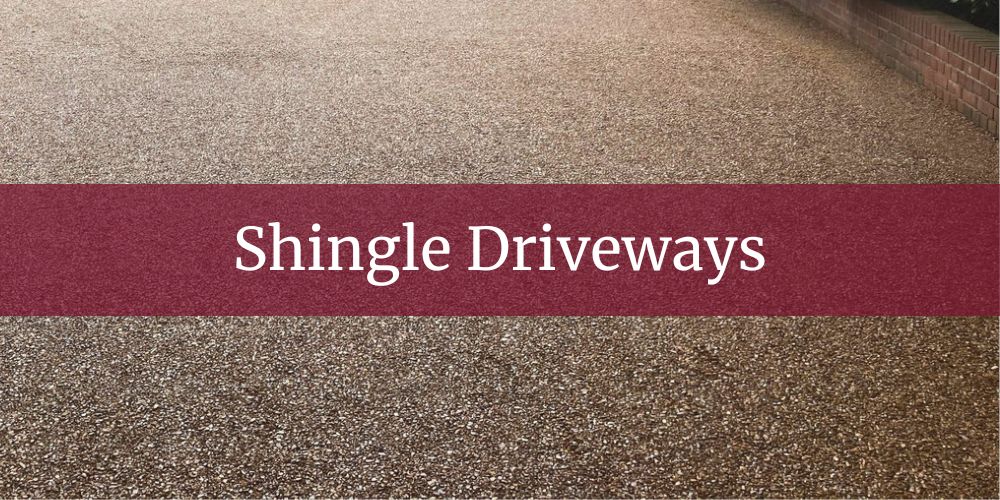Driveways Chelmsford provide shingle (gravel) driveways across Chelmsford and the surrounding area. We build on a properly compacted sub-base with a weed membrane, neat edging, and optional gravel-stabilisation grids for a tidy, long-lasting finish. Naturally permeable, our shingle driveways manage rainfall effectively and are easy to maintain or extend. Book a free site survey and quote anywhere in Chelmsford and nearby Essex villages. Shingle (gravel) driveways are formed from loose aggregate laid over a properly compacted sub-base with a weed-suppressing membrane. Edging and optional gravel-stabilisation grids keep stones contained, improve traction, and help maintain a crisp outline. Naturally permeable, gravel disperses rainfall and reduces puddling without complex drainage. They’re cost-effective, quick to install, and easy to maintain with occasional raking, weed control, and periodic top-ups.
What Are Shingle (Gravel) Driveways?
Shingle (gravel) driveways are loose-aggregate surfaces laid over a compacted MOT Type 1 sub-base, typically with a weed-suppressing membrane and neat edging to contain the stones. They’re naturally permeable and budget-friendly, helping water soak away and supporting SUDS-friendly designs when combined with correct levels, soakaways or channels where needed. For added stability on slopes or turning circles, gravel-stabilisation grids (honeycomb cells) minimise tracking, rutting, and migration onto pavements. In Chelmsford, Essex—from Writtle and Broomfield to Great Baddow, Galleywood, and Boreham—gravel suits both period homes and rural plots, with sizes and colours to match local brickwork. The surface gives a subtle crunch underfoot and tyres, which many homeowners value as a natural security cue. Maintenance is straightforward: occasional raking, weed control, and periodic top-ups to maintain depth and a tidy finish across Chelmsford and nearby villages.
Have a question about an upcoming project?
What Are The Benefits Of Having A Shingle (Gravel) Driveway In Chelmsford?
Shingle (gravel) driveways are a cost-effective, naturally permeable option that suits Chelmsford’s mixed housing—from Old Moulsham and Writtle to Great Baddow and Boreham. Laid over a compacted sub-base with neat edging (and optional stabilisation grids), gravel stays tidy and drains freely to support SUDS. The look is timeless and easy to match with local brickwork and planting, while the subtle crunch under tyres offers a handy security cue. Upkeep is simple: occasional raking, weed control, and periodic top-ups keep the surface looking fresh for years.
- Cost-effective — lower upfront cost; easy, inexpensive repairs
- Permeable & SUDS-friendly — water soaks away, fewer puddles
- Fast & flexible — quick to install; simple to extend or re-shape
- Timeless kerb appeal — suits period streets and rural plots around Chelmsford
- Low maintenance — occasional raking/top-ups; grids reduce stone migration
1. Cost-effective — lower upfront cost; easy, inexpensive repairs
Gravel is one of the most budget-friendly driveway options, often costing significantly less upfront than resin, block paving, or porcelain finishes. Materials are widely available across Essex, so you’re not paying a premium for specialist products or long-haul transport. Choose angular 10–20 mm aggregates and allow ~40–50 mm loose gravel over a compacted MOT Type 1 sub-base (typically 100–200 mm, depending on ground conditions) for a stable, economical build. If ruts or low spots develop, a quick re-grade with a rake and plate compactor plus a modest top-up of stone restores levels—no specialist tools required. This makes gravel ideal for longer drives or shared access lanes around Chelmsford where large areas can inflate costs; you can also phase upgrades and DIY top-ups to spread spend. Savings can be redirected into kerbs, gates, lighting, or planting that lifts the whole frontage without blowing the budget.
2. Permeable & SUDS-friendly — water soaks away, fewer puddles
Angular shingle naturally lets rainwater pass through to the base, helping reduce surface water and puddling during Essex downpours. For best permeability, pair the surface with a geotextile separator and, where soils allow, an open-graded Type 3 sub-base; on heavier clays common around Chelmsford, add a small soakaway or a discreet threshold/linear drain to manage peak flows. Set gentle falls (around 1:60–1:80) away from the house so water clears door thresholds while still draining through the gravel. Stabilisation grids (honeycomb cells) limit stone migration on slopes and turning circles, improving infiltration and keeping surfaces even. Simple details—silt traps on outlets, leaf guards near trees, and periodic raking to break up fines—keep the system free-draining year-round. The result is a SUDS-friendly driveway that stays usable and tidy in Chelmsford’s changeable weather without relying on intrusive channel drains.
3. Fast & flexible — quick to install; simple to extend or re-shape
Gravel driveways go in fast because there’s no curing time for binders or mortars—once the MOT Type 1 sub-base is compacted (in ~50 mm lifts) and the shingle is spread, you can usually drive on the same day. A geotextile separator under the sub-base keeps fines out and makes future alterations cleaner. If you want to add a parking bay, widen the entrance, or reroute a path later, it’s as simple as extending the excavation, tying in the sub-base, and blending fresh stone with the existing—order the same grade and mix old/new to avoid a visible line. Service upgrades (EV charger ducts, drainage runs, irrigation) are straightforward too: open a trench, install, re-grade, and top up. This flexibility suits evolving households in Beaulieu, Channels, and other new Chelmsford developments where layouts and parking needs often change over time.
4. Timeless kerb appeal — suits period streets and rural plots around Chelmsford
Pick angular 10–20 mm gravel (not rounded pea shingle) for a crisp look that interlocks under tyres and echoes local brick and flint tones in Old Moulsham and Writtle. Warmer buff and honey mixes complement traditional brickwork, while silver/grey granites suit more contemporary façades; multi-size blends add texture and lock together better. Frame the surface with neat edging—granite setts on concrete haunch, block kerbs, steel edging, or oak sleepers—to hold clean lines against lawns and borders. Planting (lavender strips, low box hedging, or grasses) softens the edges; leave a small lip on the edging so stones don’t stray into beds. The subtle “crunch” under tyres provides a gentle security cue, and the overall effect is classic, understated, and easy to coordinate across Chelmsford’s mix of urban and rural plots.
5. Low maintenance — occasional raking/top-ups; grids reduce stone migration
Routine care is light: rake wheel tracks now and then, spot-spray wind-blown weeds, and top up with a few bags of the same grade stone when depth looks low. A weed-suppressing membrane limits growth from below (note that most weeds arrive from seed above), and stabilisation grids (honeycomb cells) dramatically cut stone movement on slopes or turning circles. Keep the frontage tidy by blowing or sweeping stray stones back from pavements, and consider a slightly coarser blend at the threshold to reduce scatter. In winter, use a plastic shovel (not metal) and avoid aggressive de-icing salts near steel edging; a calcium-based de-icer or plain grit is kinder to materials. With these basics—and an occasional check/clear of any silt traps—gravel stays smart with minimal time and cost for Chelmsford homeowners.


